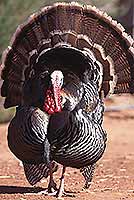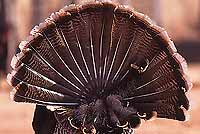Turkeys hold a special place in the history of the American Southwest. Archaeological evidence from over 2,000 years ago indicates that these birds were domesticated more for their feathers than their meat. The features were used for ceremonial purposes and raising them meant an endless supply. Archaeologists from Washington State University found abundant amounts of turkey coprolites (poop) and few bones in ancient middens dated from around 100 BC to 500 AD indicating the birds were raised for reasons other than food. Local Four Corners independent domestication was also enhanced from domesticated stocks that came originally from Mexico and then later from the Midwest. By around 900 AD, archaeological evidence indicates the birds were being consumed for food.
Prayer sticks made with wrapped turkey feathers, feather robes, bone whistles, and rock art images attest to the birds holding a unique position amongst the early Ancestral Puebloans. Domestication of wild turkeys may have been passed northward from the Aztecs who also raised these fowl.
Today, wild turkeys inhabit nearly all 49 states, including Hawaii, and portions of Mexico, thanks to reintroductions by the Turkey Federation and other organizations.
Wild turkeys breed in the spring. Adult male turkeys, known as toms or gobblers, spread their tail feathers in a fan pattern and strut to attract females. Averaging about 20 pounds, these males outweigh the hens, or females, by about 10 pounds.
After breeding, the hens lay 10-12 buff-colored eggs in a ground nest that is built under protective shrubs. The female is wary of ground predators such as coyotes, foxes, bobcats, and skunks, and relies on her cryptic coloration to blend into her surroundings. If successful, the eggs hatch in about 28 days and the mobile young leave the nest soon after hatching.
The young, called poults, follow the female and forage on adults insects and larvae as they quickly grow. The poults grow in their flight feathers in about 10-14 days so they can fly short distances to avoid predators. Though the poutls and adults seem to large to fly, the are capable of flying up into trees to roost or flee those predators. At times, the birds may fly up into trees to consume berries or nuts such as acorns and walnuts. The bird’s powerful gizzards can grind up shells as wells as seeds, insects, waste grain, tree buds, and other nuts. 
After Spanish Colonialism reached the New World in 1539, the introduction of sheep and chicken may have led to declines in turkey husbandry in the Southwest. Eventually, the Spanish conquistadors brought some wild turkeys from the New World back to Europe which launched more animal husbandry and breeding programs to develop new stock. When the early colonists sailed from Europe to the New World, they brought turkeys with them for food.
In the US, November is a month that features the turkey, maybe not the wild variety, on center stage during Thanksgiving. Perhaps it is fitting, during that celebration, to raise a toast to the wild birds which once roamed this continent and whose character even led Benjamin Franklin to propose that turkeys, not the pirating bald eagle, be adopted as the symbol of a fledgling nation.